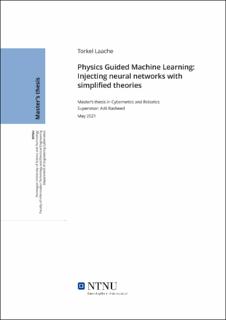| dc.contributor.advisor | Rasheed, Adil | |
| dc.contributor.author | Laache, Torkel | |
| dc.date.accessioned | 2021-09-23T18:53:11Z | |
| dc.date.available | 2021-09-23T18:53:11Z | |
| dc.date.issued | 2021 | |
| dc.identifier | no.ntnu:inspera:76427839:34431607 | |
| dc.identifier.uri | https://hdl.handle.net/11250/2781061 | |
| dc.description.abstract | Eksponentiell vekst i datakraft og tilgjengelighet av store datasett har popularisert og forbedret maskinlæring betydelig de siste årene. Nevrale nettverk er sterke verktøy som kan oppdage mønstre i komplekse datasett og muligens modellere realistiske dynamiske systemer. Denne oppgaven undersøker et "physics-guided machine learning" rammeverk for nevrale nettverk ved å kombinere tradisjonell matematisk modellering med maskinlæringsmetoder. Her injiseres nevrale nettverk med forenklede teorier om dynamiske systemer for å forbedre nøyaktigheten og tolkningen. For å validere rammeverket gjennomgår det flere eksperimenter på forskjellige systemer som Lotka-Volterra-ligningene, Duffing-oscillatoren, Lorenz-systemet, Hindmarsh-Rose modellen og WillamowskiRössler modellen. Resultatene indikerer at det foreslåtte rammeverket kan forbedre
nevrale nettverk og brukes i forskjellige vitenskapelige maskinlæringsapplikasjoner, spesielt i systemer der en forenklet modell kan hjelpe læringsprosessen. | |
| dc.description.abstract | Exponential growth in computing power and availability of large datasets has popularized and progressed machine learning substantially in recent years. Neural networks are potent approximators capable of discovering patterns in complex datasets and possibly model realistic dynamical systems. This thesis investigates a physics-guided machine learning framework of neural networks that combines traditional mathematical modeling with machine learning methods. Here, neural networks are injected with simplified theories of dynamical systems at intermediate layers to improve their accuracy and interpretability. To
validate the framework, it undergoes several experiments on various systems such as the Lotka-Volterra equations, Duffin oscillator, Lorenz system, Hindmarsh–Rose model, and Willamowski-Rössler model. The results indicate that the proposed framework can enhance the neural networks and be used in various scientific machine learning applications, particularly in systems where simplified theories can guide the learning process. | |
| dc.language | eng | |
| dc.publisher | NTNU | |
| dc.title | Physics Guided Machine Learning:
Injecting neural networks with
simplified theories | |
| dc.type | Master thesis | |
